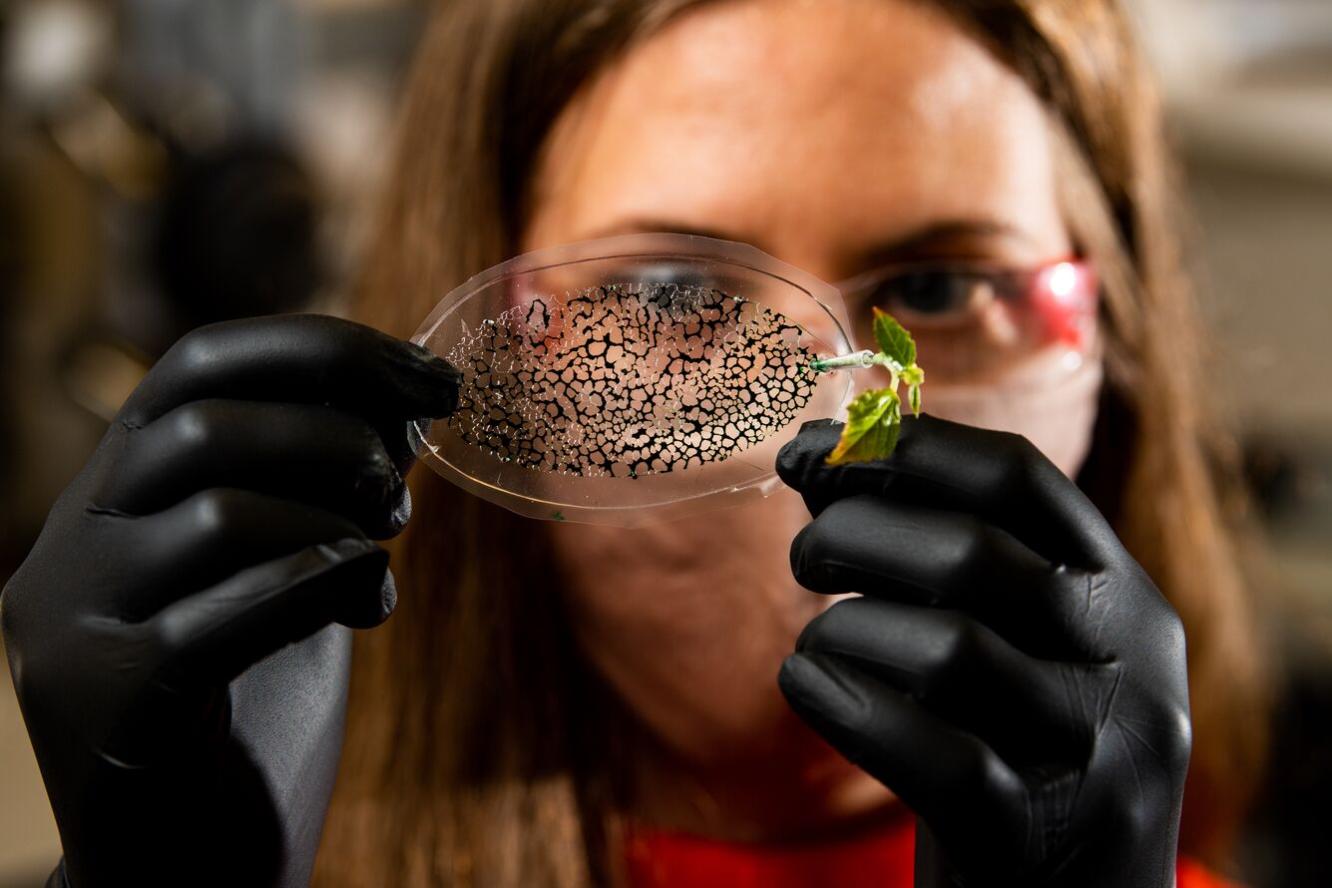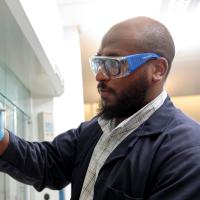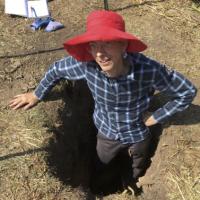Ten Months, Twenty Projects, and Countless Scientific Advancements
EMSL awards 20 projects through Exploratory Call

The Environmental Molecular Sciences Laboratory (EMSL) selected 20 recipients of funding from its annual Exploratory Call. Over the next 10 months, researchers and teams from across the country will evaluate resources for carbon storage, model water systems, examine biological systems as bioenergy sources, and more.
The call sought proposals that address at least one of three scientific focus areas: Environmental Transformations and Interactions, Functional and Systems Biology, and Computing Analytics and Modeling. EMSL piloted an anonymized peer review process for this call.
EMSL offers 150 instruments at no cost to proposal awardees. These instruments include the in-house-developed nanoPOTS technology as well as transmission and scanning electron microscopes, X-ray photoelectron spectroscopy, Fourier-transform ion cyclotron resonance mass spectrometry, X-ray diffraction, Mössbauer spectroscopy, nanoSIMS, atom probe tomography, X-ray computed tomography, confocal Raman microspectroscopy, nuclear magnetic resonance spectroscopy, and matrix-assisted laser desorption ionization as a mass spectrometry, known as MALDI, to name a few.
The awarded projects include the following:

Maruti K. Mudunuru
Pacific Northwest National Laboratory
ModEx benchmark: artificial intelligence for benchmarking model-experiment integration workflows
This research uses field datasets to accurately estimate the 3D permeability field for modeling river water intrusion and tracer transport into the subsurface. Accurate estimation of the permeability field is essential for a predictive understanding of the infiltration process and for developing realistic subsurface process models for natural and engineered systems.
Kate Hanna Kucharzyk

Battelle Columbus
SynThetic biolOgy driven approach to Repurpose polyaMides (STORM)
Nylon-6 (PA6) is a polyamide polymer abundant in clothing, ropes, fabrics, and automobile parts, and the United States annually consumes ~0.5 million metric tons. To divert these materials from landfills and incinerators, researchers will use synthetic biology approaches to efficiently degrade and upcycle PA6 into high-value monomers.

Qiang Guan
Kent State University
AlphaEnzyme: predicting enzyme functions directly from AlphaFold encoding
Predicting the function of enzymes helps us understand the metabolic potentials of microbes and microbiomes. With the help of large training sets of protein structures and EMSL’s supercomputer, the team proposes building a machine learning pipeline that is capable of quickly generating intermediate representation of proteins to enable prediction of enzyme functions.

Karen Sanguinet
Washington State University
This research aims to unearth molecular cues that underlie cell wall remodeling during root hair emergence and lateral root initiation. Further understanding of these root traits is key to improving bioenergy crop sustainability and increasing feedstock production in marginal environments.
Erin Clarissa Rooney

University of Tennessee
Arctic warming is accelerating permafrost thaw, exposing previously frozen soil to repeated freeze-thaw cycles. The project will assess the role of pore geometry on geochemical transformations and redox gradients. Results will help determine how the pore-scale effects of freeze-thaw may alter redox chemistry, nutrient availability, and carbon loss in a warming Arctic.

Daniel David Gregory
University of Toronto
Detailed analysis of sulfur isotopic signatures via atom probe tomography
Under low oxygen conditions, some organisms use sulfate for respiration instead of oxygen. When this occurs, sulfide is expelled, reacting with iron to form pyrite. This project aims to further understand the sulfur cycle by obtaining nanoscale S-isotope analyses of pyrite.

Lisamarie Windham-Myers
U.S. Geological Survey
Pore-scale evidence of tidal wetland soil carbon stabilization
At a mechanistic level, the scientific community needs to better understand the capacity of vegetated coastal ecosystems to preserve organic carbon. This study will couple physical, ecological, and chemical observations spatially—within neighboring but geomorphically distinct tidal marsh soils—to prioritize sampling for future landscape model development.

Idowu Ademola Atoloye
North Carolina A&T State University
Understanding the interactions between plant organic molecules and soil minerals is critical in biogeochemical processes. This project will use rhizosphere-on-a-chip to clarify the intricate and mechanistic processes of the adsorptive interaction of root exudates and soil minerals.

Sabeeha Sabanali Merchant
University of California, Berkeley
As light and carbon dioxide availability changes, plants and algae employ short-term acclimation strategies to maximize photosynthetic yield and minimize potential cell damage. This project intends to define the compositional dynamics in the photosynthetic apparatus so that we can better understand similar adjustments in genetically engineered algae for eventual use in bioproduct production.
Amy Marshall-Colon

University of Illinois at Urbana-Champaign
Developing a protocol for spatial metabolomics to investigate cell types in the Sorghum bicolor stem
Engineering sorghum bicolor stems to accumulate bioproducts could decrease the burden on conversion groups in the biofuel industry. This project seeks to expand our understanding of stem cell types and the metabolic dynamics between them, thus creating a molecular atlas of sorghum stem development and increasing our understanding of grass stem biology.

Amy Schmid
Duke University
Modeling microbial community metabolic interactions in hypersaline ecosystems
Hypersaline microbial communities have the potential to teach us about general principles of community resilience to environmental perturbation. However, the mechanisms of metabolic interactions within these microbial communities remain largely uncharacterized. The proposed research will use metabolomics methods to investigate how hypersaline microbial communities interact to maintain stability despite changes in salinity and nutrient availability.

Pavlo Bohutskyi
Pacific Northwest National Laboratory
The project continues research into developing a novel biological process based on the superior hydrolytic and metabolic capabilities of the hyperthermophilic microbial communities proliferating at temperatures of 70 degrees Celsius and above. This innovative process aims to significantly improve carbon conversion efficiency and to reduce the overall processing time, thereby minimizing capital and operating costs.

Anne Melissa Gothmann
St. Olaf College
This project will develop a baseline nanoscale understanding of organic matter and water in an existing sample set of natural and cultured coral skeletons. The fundamental results would be a stepping stone for understanding how nanoscale patterns in organics and water in coral skeletons vary in direct response to changing environmental conditions.
Jean Carlos Rodriguez Ramos

United States Department of Agriculture - Agricultural Research Service Water Management Research
Agricultural cover crops can affect the longer-term stabilization of soil organic carbon, but details of how they do it remain understudied. This project will build on a current soil biological health assessment using data on how cover crop species differentially modulate soil properties important for soil carbon accrual and sequestration.

Charles James Werth
University of Texas at Austin
This project will create a specialized microfluidic soil habitat to test the hypothesis that bacteria will spatially segregate in a model soil system according to the location and reduction potential of different solid-phase ferric iron minerals present and the quantity and type of extracellular electron shuttles they produce.

Marcus Bernard Foston
Washington University in St. Louis
Characterization of novel synthetic biological materials
Synthetic biology and genome engineering allow us to harness the machinery of nature to produce synthetic biological materials. In this project, researchers seek to redesign recombinant chimeric proteins based on proteins found in mussel feet so that they produce hydrogels with enhanced properties for applications that require underwater adhesives.

Michael Enoch Green
City College of New York
This project will use structures from known proton transmitters to calculate the energy for proton paths. The aim is to find paths that allow protons to proceed without major energy barriers and determine whether there are general properties found in configurations of these successful paths.

Matthew Owen Schrenk
Michigan State University
Terranes of rock formations known as serpentinites are an understudied site of key biogeochemical transformations that are also being considered as sites for carbon capture and storage. This research seeks to create large-scale biogeochemical models that can predict microbial activities in serpentine soils and their response to environmental change.

Benjamin Gilbert
Lawrence Berkeley National Laboratory
Rhizosphere promoted rock weathering and nutrient cycling in deep shale fractures
This project seeks to determine the geologic, biological, and biochemical structure of the rhizosphere that develops in deep shale fractures and correlate that information with geochemical signatures of shale weathering. The work could enable unprecedented insight into the earliest stages of plant-influenced bedrock weathering and soil formation.

Bjoern Robert Hamberger
Michigan State University
This project aims to establish biological relevance and tools for predicting and shaping the microbiome to increase plant resilience. Researchers will accomplish this by increasing their fundamental understanding of the sorghum root microbiome and its expression of terpene metabolism.

